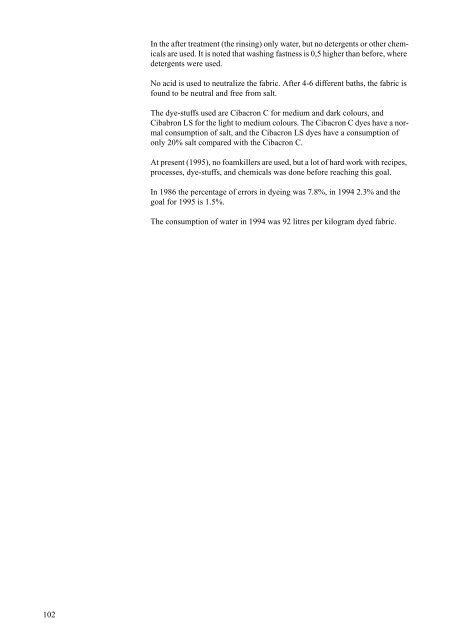Cleaner Technology Transfer to the Polish Textile ... - Miljøstyrelsen
Cleaner Technology Transfer to the Polish Textile ... - Miljøstyrelsen
Cleaner Technology Transfer to the Polish Textile ... - Miljøstyrelsen
You also want an ePaper? Increase the reach of your titles
YUMPU automatically turns print PDFs into web optimized ePapers that Google loves.
102<br />
In <strong>the</strong> after treatment (<strong>the</strong> rinsing) only water, but no detergents or o<strong>the</strong>r chemicals<br />
are used. It is noted that washing fastness is 0,5 higher than before, where<br />
detergents were used.<br />
No acid is used <strong>to</strong> neutralize <strong>the</strong> fabric. After 4-6 different baths, <strong>the</strong> fabric is<br />
found <strong>to</strong> be neutral and free from salt.<br />
The dye-stuffs used are Cibacron C for medium and dark colours, and<br />
Cibabron LS for <strong>the</strong> light <strong>to</strong> medium colours. The Cibacron C dyes have a normal<br />
consumption of salt, and <strong>the</strong> Cibacron LS dyes have a consumption of<br />
only 20% salt compared with <strong>the</strong> Cibacron C.<br />
At present (1995), no foamkillers are used, but a lot of hard work with recipes,<br />
processes, dye-stuffs, and chemicals was done before reaching this goal.<br />
In 1986 <strong>the</strong> percentage of errors in dyeing was 7.8%, in 1994 2.3% and <strong>the</strong><br />
goal for 1995 is 1.5%.<br />
The consumption of water in 1994 was 92 litres per kilogram dyed fabric.

















